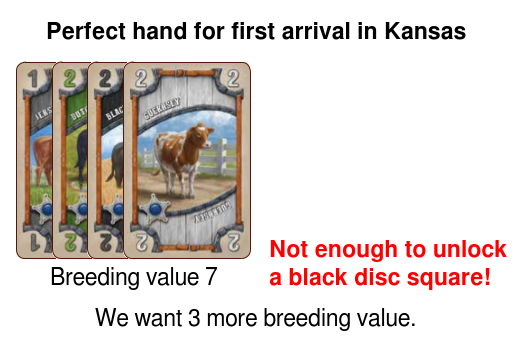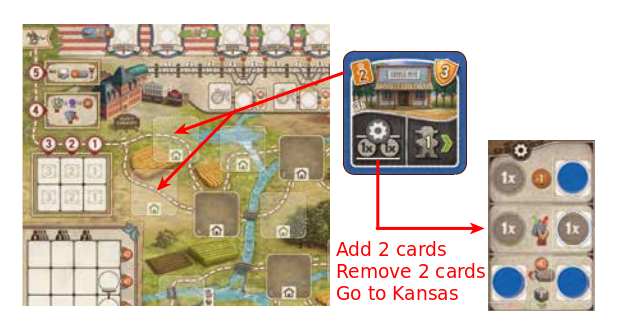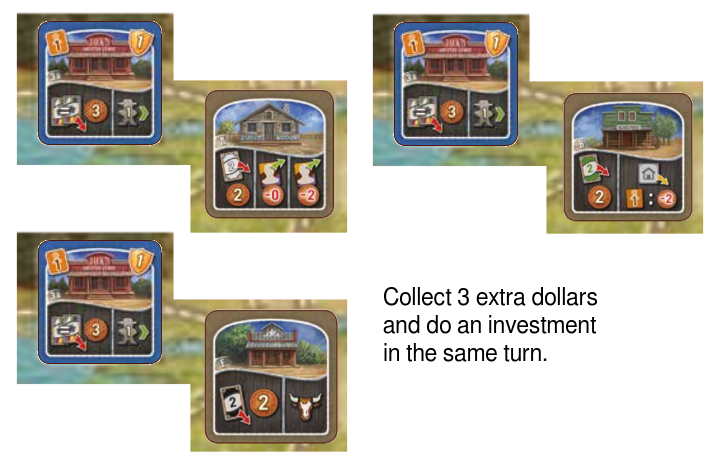
Generally speaking, we can play 3 macro strategies, based on the workers we buy:
cowboys (cattle): an easy strategy, great for a first game
craftsmen (buildings): the most rewarding and most challenging strategy
engineers (train progress): a flexible strategy that combines well with the others

Regardless of our main strategy - and which type(s) of workers we invest in - we always need to:
Buy at least 2 cattle to increase our Kansas income and disc abilities.
Even if we won’t buy cowboys
Build some buildings to do more/better actions per turn and derail other players.
Even if we won’t buy craftsmen
Advance our train somewhat to decreases taxes on our Kansas income and acquire permanent bonuses.
Even if we won’t buy engineers.
The cowboys (cattle) strategy is the easiest to start with. The engineers (train progress) strategy is a bit more challenging. But the craftsmen (buildings) strategy is - by far - the most rewarding and most challenging to play.
That being said, let’s start with the basics: increase our Kansas income enough to unlock black disc abilities.
In Kansas, we sell our distinct hand cards for the sum of their breeding value. It’s vital to increase this income as soon as possible, because it gives us several advantages:
More income allows us to hire 2 workers a once, buy more/better cattle or buy bigger buildings.
Deliver to higher cities:
Unlock black disc squares. These are vital to get our engine running, to snow ball.
Gain victory points (instead of losing them).
We start with 14 cattle cards (5 gray, 3 green, 3 black and 3 white) and only 4 hand cards. If we arrive in Kansas with a perfect hand, we have an income of only 7:

Yet, we need an income of at least 10 to unlock the first black disc square, so we’re 3 income short! To increase income, we can buy better cattle, increase our hand card limit or acquire certificates. Certificates are mostly a temporarily gain, so let’s focus on improving our delivery hand first:

To significantly increase our income permanently, we want to buy at least 2 cattle cards and increase our hand limit by 1 early in the game, even if cattle isn’t our main strategy. But because we start out with only 4 different card types, it is useless to first increase our hand limit (to 5 hand cards) before buying our first cattle card. So buy cattle first.
Buying cattle is expensive and that new cattle card ends up in our discard pile. We want to buy cattle before we reshuffle our deck the first time, ideally even just before we reshuffle it. And we want to go through our deck quickly too, so that level 3/4/5 cattle card is in our hand when we arrive in Kansas.
Buy a cattle card color that you haven’t bought yet, to combine them more easily when selling them in Kansas. The cattle cards have victory points too, so buy the ones with more victory points first.
Increasing our hand limit is a great investment, which is definitely worth the additional 5 dollar cost, because of 2 advantages:
In Kansas, 1 extra card can sell for 1-5 extra dollars, which increases not just our Kansas income, but also our victory point income and the likelihood of placing a black disc square.
On the road, it increases the likelihood of selling a green/black/white/gray card and going through our deck quickly.
With 5 hand cards, we have roughly 25% more chance to hold at least one white card than with 4 hand cards.
The same 25% roughly applies to other card types (gray/green/black).
The chance to hold a specific card type does affect that chance (gray cards have a higher chance), but not enough to take it into account.
So we’re 25% more likely to be able to sell that white card for 2 dollars before buying a worker.
And we’re going through our deck faster, so we’re more likely to arrive with the expensive cattle in Kansas.
To increase our hand limit, we need to reach a delivery city with a black disc square and pay 5 dollars. The first one requires an income of 10, the second an income 12.
If we have an income of 10, but our train hasn’t reached the first red X yet but the lack of train progress will cost us an extra 5 dollars, on top of the 5 dollars ability cost, leaving us flat broke for the next trail. This could waste 3 rounds easily. It’s a good idea to stockpile dollars beforehand to avoid this situation, including take the 6 dollars for a loss of 6 victory points during your first delivery.
The alternative, using the 10 income delivery for the ability to walk faster, is dangerous: without that 5th hand card, it is very difficult to reach 12 income later on. However if we’re playing an engineer strategy, we can deliver a black disc to the train track too.
To bridge the gap between our hand’s income and the required 10 income threshold, certificates are extremely useful.
From the train track, it’s possible to gain up to 3 permanent certificates. These are worth fighting for, especially if we’re playing an engineer strategy.
In the beginning of the game, it’s worth investing in increasing the certificate marker. We only spend those one-time-use certificates in Kansas if it helps reach the 10 income limit to increase our hand limit. They aren’t worth spending to reach 8 income and avoid victory point loss, unless the rest of our deck is stuff with high value cattle, so we won’t need them next time we’re in Kansas.
When taking train movement actions, try to jump over other player’s trains, as these are extra free movements. Avoid departing first, unless you can break free of the pack so they can’t benefit from jumping over you.
Don’t let the pack leave without you: they’ll constantly jump over each other and you’ll need to spend up to twice as many train movement actions later to reach a city. And sooner or later you’ll want to reach city’s with your train to reduce the red X costs.
The buildings that let us move forward too are especially powerful. Let’s call these leapfrog buildings. They increase our actions per turn and get us to Kansas sooner. A couple of examples:
Place building 3b right before Kansas and use to maximize your hand before selling it.

Place building 3a right before an expensive neutral action.

There is a finesse to doing this right:
First identify a location to land on every trail.
Great candidates are the hire employees building, the construct building and Kansas.
Then place your leapfrog building the number of steps it jumps before it.
Count empty spaces as if they’re filled up already, because that will happen soon enough.
Most players believe in building the tax building 1a or 1b as soon as possible, typically on the alternative road from one with obstacles. This works well in the beginning.
But you can take advantage of this, if you can muster the funding: on the alternative road, build after after the hazard tiles (those building locations give extra bonuses) and clear the hazard tiles. Their tax houses become useless and your building(s) have a bonus.
Comments